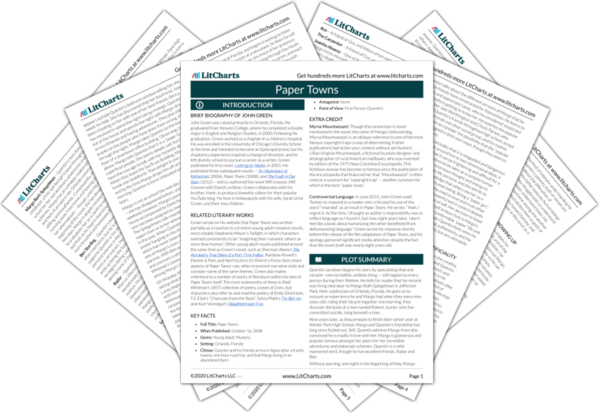Welcome to the LitCharts study guide on John Green's Paper Towns. Created by the original team behind SparkNotes, LitCharts are the world's best literature guides.
Paper Towns: Introduction
Paper Towns: Plot Summary
Paper Towns: Detailed Summary & Analysis
Paper Towns: Themes
Paper Towns: Quotes
Paper Towns: Characters
Paper Towns: Symbols
Paper Towns: Theme Wheel
Brief Biography of John Green

Other Books Related to Paper Towns
- Full Title: Paper Towns
- When Published: October 16, 2008
- Genre: Young Adult, Mystery
- Setting: Orlando, Florida
- Climax: Quentin and his friends arrive in Agloe after a frantic twenty-one hour road trip, and find Margo living in an abandoned barn.
- Antagonist: None
- Point of View: First Person (Quentin)
Extra Credit for Paper Towns
Myrna Mountweazel. Though the connection is never mentioned in the novel, the name of Margo’s beloved dog, Myrna Mountweazel, is an oblique reference to one of the most famous copyright traps (a way of determining if other publications had stolen your content without attribution): Lillian Virginia Mountweazel, a fictional fountain designer and photographer of rural American mailboxes, who was invented by editors of the 1975 New Columbia Encyclopedia. This fictitious woman has become so famous since the publication of the encyclopedia that featured her that “Mountweazel” is often used as a synonym for “copyright trap” — another synonym for which is the term “paper town.”
Controversial Language. In June 2015, John Green used Twitter to respond to a reader who criticized his use of the word “retarded” as an insult in Paper Towns. He wrote: “Yeah, I regret it. At the time, I thought an author’s responsibility was to reflect language as I found it, but now, eight years later, I don’t feel like a book about humanizing the other benefitted from dehumanizing language.” Green wrote his response shortly before the release of the film adaptation of Paper Towns, and his apology garnered significant media attention despite the fact that the novel itself was nearly eight years old.







